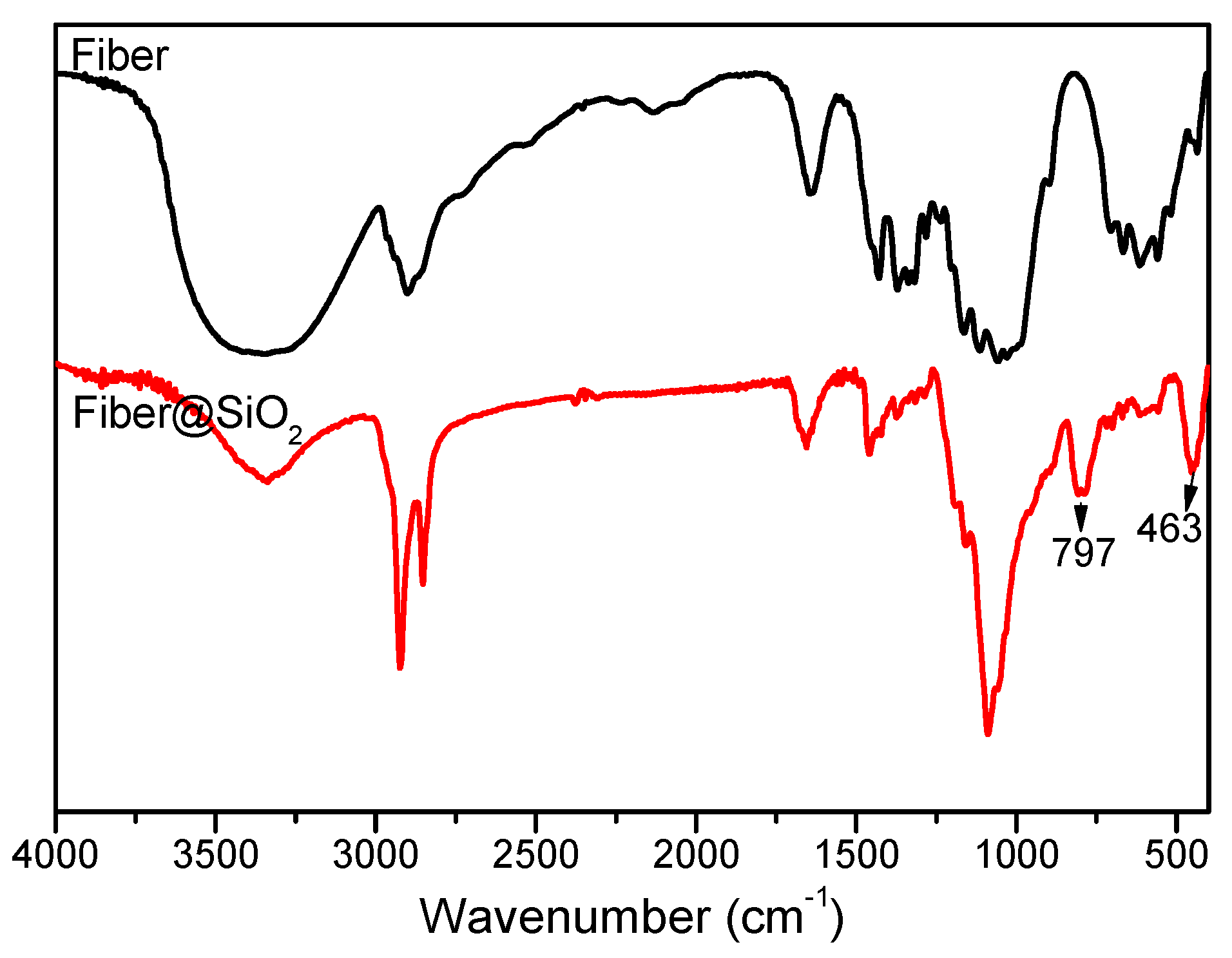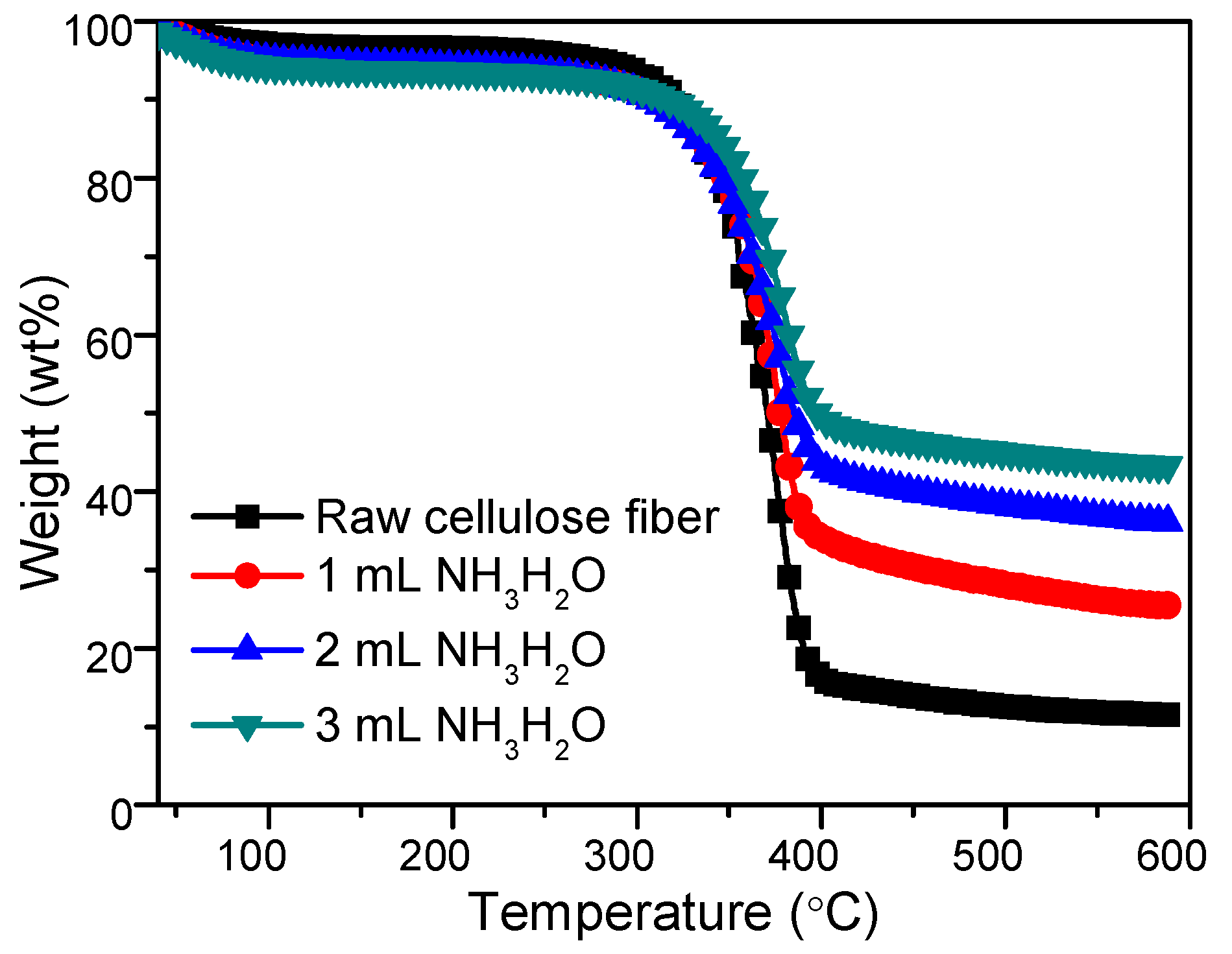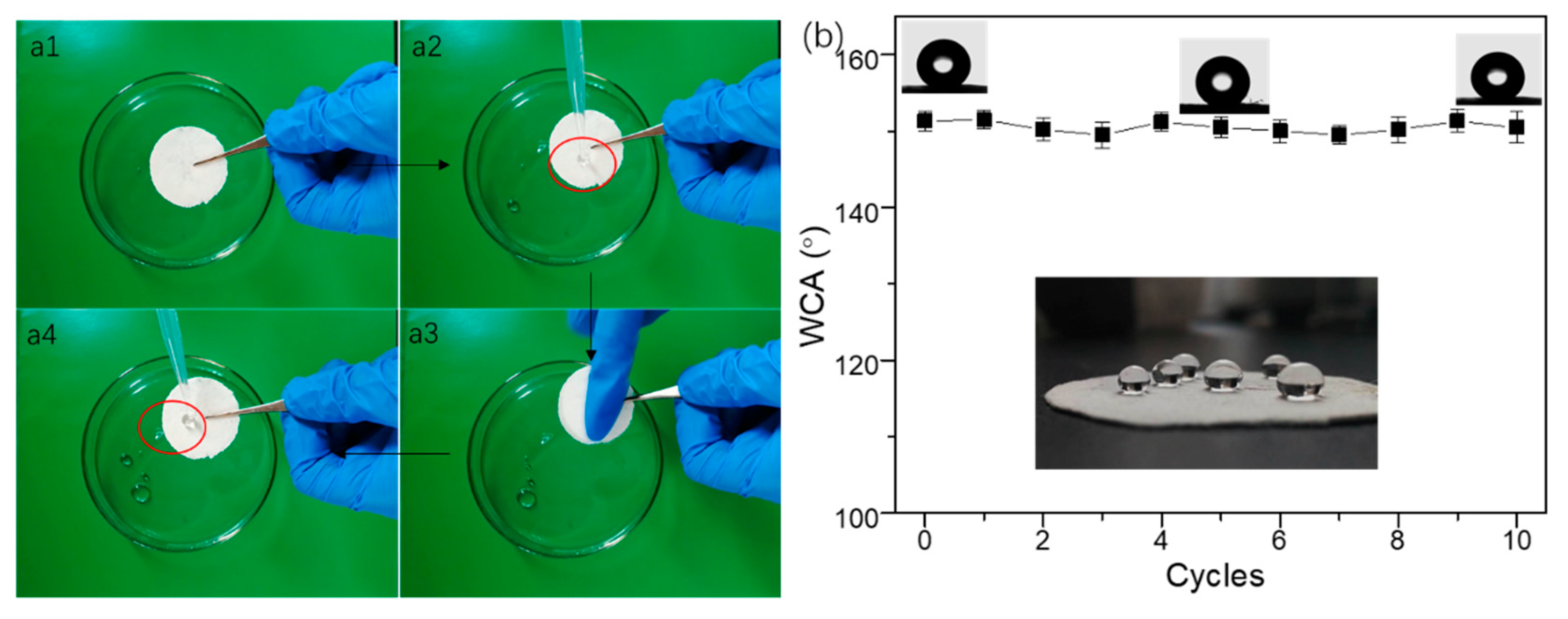Facile Approach to Develop Hierarchical Roughness fiber@SiO2 Blocks for Superhydrophobic Paper
Abstract
1. Introduction
2. Materials and Methods
2.1. Materials
2.2. Synthesis of Silica Modified Cellulose Fibres
2.3. Fabrication of Superhydrophobic Paper
2.4. Characterization
3. Results
3.1. Composition Analysis
3.2. Surface Wettability Property
4. Conclusions
Supplementary Materials
Author Contributions
Funding
Conflicts of Interest
References
- Klemm, D.; Heublein, B.; Fink, H.P.; Bohn, A. Cellulose: Fascinating Biopolymer and Sustainable Raw Material. Angew. Chem. Int. Edit. 2005, 44, 3358–3393. [Google Scholar] [CrossRef] [PubMed]
- Zhang, W.; Lu, P.; Qian, L.; Xiao, H. Fabrication of superhydrophobic paper surface via wax mixture coating. Chem. Eng. J. 2014, 250, 431–436. [Google Scholar] [CrossRef]
- Yang, L.; Lu, S.; Li, J.; Zhang, F.; Cha, R. Nanocrystalline cellulose-dispersed AKD emulsion for enhancing the mechanical and multiple barrier properties of surface-sized paper. Carbohyd. Polym. 2016, 136, 1035–1040. [Google Scholar] [CrossRef]
- Adenekan, K.; Hutton-Prager, B. Sticky hydrophobic behavior of cellulose substrates impregnated with alkyl ketene dimer (AKD) via sub- and supercritical carbon dioxide. Colloid. Surface. A 2019, 560, 154–163. [Google Scholar] [CrossRef]
- Zhang, X.; Batchelor, W.; Shen, W. Building Dual-Scale Roughness Using Inorganic Pigments for Fabrication of Superhydrophobic Paper. Ind. Eng. Chem. Res. 2017, 56, 3618–3628. [Google Scholar] [CrossRef]
- Suryaprabha, T.; Sethuraman, M.G. Fabrication of copper-based superhydrophobic self-cleaning antibacterial coating over cotton fabric. Cellulose 2017, 24, 395–407. [Google Scholar] [CrossRef]
- Tripathy, A.; Kumar, A.; Sreedharan, S.; Muralidharan, G.; Pramanik, A.; Nandi, D.; Sen, P. Fabrication of Low-Cost Flexible Superhydrophobic Antibacterial Surface with Dual-Scale Roughness. ACS Biomater. Sci. Eng. 2018, 4, 2213–2223. [Google Scholar] [CrossRef]
- Li, S.; Page, K.; Sathasivam, S.; Heale, F.; He, G.; Lu, Y.; Lai, Y.; Chen, G.; Carmalt, C.J.; Parkin, I.P. Efficiently texturing hierarchical superhydrophobic fluoride-free translucent films by AACVD with excellent durability and self-cleaning ability. J. Mater. Chem. A 2018, 6, 17633–17641. [Google Scholar] [CrossRef]
- Sun, S.; Zhu, L.; Liu, X.; Wu, L.; Dai, K.; Liu, C.; Shen, C.; Guo, X.; Zheng, G.; Guo, Z. Superhydrophobic Shish-kebab Membrane with Self-Cleaning and Oil/Water Separation Properties. ACS Sustainable Chem. Eng. 2018, 6, 9866–9875. [Google Scholar] [CrossRef]
- Latthe, S.S.; Sudhagar, P.; Devadoss, A.; Kumar, M.; Liu, S.; Terashima, C.; Nakata, K.; Fujishima, A. A mechanically bendable superhydrophobic steel surface with self-cleaning and corrosion-resistant properties. J. Mater. Chem. A 2015, 3, 14263–14271. [Google Scholar] [CrossRef]
- Kazuya, N.; Shunsuke, N.; Atsushi, K.; Donald, T.; Tsuyoshi, O.; Taketoshi, M.; Fujishima, A. Fabrication and Application of TiO2-Based Superhydrophilic–Superhydrophobic Patterns on Titanium Substrates for Offset Printing. Chem Asian J. 2009, 4, 984–988. [Google Scholar]
- Das, S.R.; Srinivasan, S.; Stromberg, L.R.; He, Q.; Garland, N.; Straszheim, W.E.; Ajayan, P.M.; Ganesh, B.; Jonathan, C.C. Superhydrophobic inkjet printed flexible graphene circuits via direct-pulsed laser writing. Nanoscale 2017, 9, 19058–19065. [Google Scholar] [CrossRef]
- Sun, J.; Bao, B.; Jiang, J.; He, M.; Zhang, X.; Song, Y. Facile fabrication of a superhydrophilic–superhydrophobic patterned surface by inkjet printing a sacrificial layer on a superhydrophilic surface. RSC Adv. 2016, 6, 31470–31475. [Google Scholar] [CrossRef]
- Zhang, L.; Wu, J.; Hedhili, N.M.; Yang, X.; Wang, P. Inkjet printing for direct micropatterning of a superhydrophobic surface: toward biomimetic fog harvesting surfaces. J. Mater. Chem. A 2015, 3, 2844–2852. [Google Scholar] [CrossRef]
- Gao, X.; Zhou, J.; Du, R.; Xie, Z.; Deng, S.; Liu, R.; Liu, Z.; Zhang, J. Robust Superhydrophobic Foam: A Graphdiyne-Based Hierarchical Architecture for Oil/Water Separation. Adv. Mater. 2016, 28, 168–173. [Google Scholar] [CrossRef]
- Zhang, S.; Jiang, G.; Gao, S.; Jin, H.; Zhu, Y.; Zhang, F.; Jin, J. Cupric Phosphate Nanosheets-Wrapped Inorganic Membranes with Superhydrophilic and Outstanding Anticrude Oil-Fouling Property for Oil/Water Separation. ACS Nano 2018, 12, 795–803. [Google Scholar] [CrossRef]
- Gao, S.; Dong, X.; Huang, J.; Li, S.; Li, Y.; Chen, Z.; Lai, Y. Rational construction of highly transparent superhydrophobic coatings based on a non-particle, fluorine-free and water-rich system for versatile oil-water separation. Chem. Eng. J. 2018, 333, 621–629. [Google Scholar] [CrossRef]
- Wang, Q.; Chen, G.; Tian, J.; Yu, Z.; Deng, Q.; Yu, M. Facile fabrication of fluorine-free, transparent and self-cleaning superhydrophobic coatings based on biopolymer castor oil. Mater. Lett. 2018, 230, 84–87. [Google Scholar] [CrossRef]
- Yu, M.; Wang, Q.; Zhang, M.; Deng, Q.; Chen, D. Facile fabrication of raspberry-like composite microspheres for the construction of superhydrophobic films and applications in highly efficient oil–water separation. RSC Adv. 2017, 7, 39471–39479. [Google Scholar] [CrossRef]
- Xia, Z.; Xiao, Y.; Yang, Z.; Li, L.; Wang, S.; Liu, X.; Tian, Y. Droplet Impact on the Super-Hydrophobic Surface with Micro-Pillar Arrays Fabricated by Hybrid Laser Ablation and Silanization Process. Materials 2019, 12, 765. [Google Scholar] [CrossRef]
- Guo, X.; Liang, T. Electrophoresis Assembly of Novel Superhydrophobic Molybdenum Trioxide (MoO3) Films with Great Stability. Materials 2019, 12, 336. [Google Scholar] [CrossRef]
- Lu, C.; Shi, F.; Jin, J.; Peng, X. Study on the Properties of Vertical Carbon Nanotube Films Grown on Stainless Steel Bipolar Plates. Materials 2019, 12, 899. [Google Scholar] [CrossRef] [PubMed]
- Yu, M.; Wang, Q.; Yang, W.; Xu, Y.; Zhang, M.; Deng, Q.; Liu, G. Facile Fabrication of Magnetic, Durable and Superhydrophobic Cotton for Efficient Oil/Water Separation. Polymers 2019, 11, 442. [Google Scholar] [CrossRef] [PubMed]
- Kadlečková, M.; Minařík, A.; Smolka, P.; Mráček, A.; Wrzecionko, E.; Novák, L.; Musilová, L.; Gajdošík, R. Preparation of Textured Surfaces on Aluminum-Alloy Substrates. Materials 2019, 12, 109. [Google Scholar] [CrossRef]
- Minařík, M.; Wrzecionko, E.; Minařík, A.; Grulich, O.; Smolka, P.; Musilová, L.; Junkar, I.; Primc, G.; Ptošková, B.; Mozetič, M.; et al. Preparation of Hierarchically Structured Polystyrene Surfaces with Superhydrophobic Properties by Plasma-Assisted Fluorination. Coatings 2019, 9, 201. [Google Scholar] [CrossRef]
- Peng, L.; Meng, Y.; Li, H. Facile fabrication of superhydrophobic paper with improved physical strength by a novel layer-by-layer assembly of polyelectrolytes and lignosulfonates-amine. Cellulose 2016, 23, 2073–2085. [Google Scholar] [CrossRef]
- Li, H.; Yang, J.; Li, P.; Lan, T.; Peng, L. A facile method for preparation superhydrophobic paper with enhanced physical strength and moisture-proofing property. Carbohyd. Polym. 2017, 160, 9–17. [Google Scholar] [CrossRef] [PubMed]
- Panagiotis, D.; Anastasios, T.; Vassilios, P.P.; Evangelos, G. Superhydrophobic Paper by Facile and Fast Atmospheric Pressure Plasma Etching. Plasma Process. Polym. 2017, 14, 1600069–1600076. [Google Scholar]
- Khanjani, P.; King, A.W.T.; Partl, G.J.; Johansson, L.; Kostiainen, M.A.; Ras, R.H.A. Superhydrophobic Paper from Nanostructured Fluorinated Cellulose Esters. ACS Appl. Mater. Interfaces 2018, 10, 11280–11288. [Google Scholar] [CrossRef]
- Avijit, B.; Mohd, A.G.; Swathy, J.R.; Kam, C.T.; Sarit, K.D.; Robin, H.A.R.; Thalappil, P. Organic Solvent-Free Fabrication of Durable and Multifunctional Superhydrophobic Paper from Waterborne Fluorinated Cellulose Nanofiber Building Blocks. ACS Nano 2017, 11, 11091–11099. [Google Scholar]
- Wang, N.; Xiong, D.; Pan, S.; Deng, Y.; Shi, Y.; Wang, K. Superhydrophobic paper with superior stability against deformations and humidity. Appl. Surf. Sci. 2016, 389, 354–360. [Google Scholar] [CrossRef]
- Ogihara, H.; Xie, J.; Okagaki, J.; Saji, T. Simple Method for Preparing Superhydrophobic Paper: Spray-Deposited Hydrophobic Silica Nanoparticle Coatings Exhibit High Water-Repellency and Transparency. Langmuir 2012, 28, 4605–4608. [Google Scholar] [CrossRef]
- Karapanagiotis, I.; Grosu, D.; Aslanidou, D.; Aifantis, K.E. Facile Method to Prepare Superhydrophobic and Water Repellent Cellulosic Paper. J. Nanomater. 2015, 16, 1–9. [Google Scholar] [CrossRef]
- Aslanidou, D.; Karapanagiotis, I.; Lampakis, D. Waterborne Superhydrophobic and Superoleophobic Coatings for the Protection of Marble and Sandstone. Materials 2018, 11, 585. [Google Scholar] [CrossRef] [PubMed]
- Karapanagiotis, I.; Pavlou, A.; Manoudis, P.N.; Aifantis, K.E. Water repellent ORMOSIL films for the protection of stone and other materials. Mater. Lett. 2014, 131, 276–279. [Google Scholar] [CrossRef]
- Wang, Q.; Yu, M.; Chen, G.; Chen, Q.; Tai, J. Facile Fabrication of Superhydrophobic/Superoleophilic Cotton for Highly Efficient Oil/Water Separation. Bioresources 2017, 12, 643–654. [Google Scholar] [CrossRef]
- Cai, Y.; Li, J.; Yi, L.M.; Yan, X.J.; Li, J.W. Fabricating superhydrophobic and oleophobic surface with silica nanoparticles modified by silanes and environment-friendly fluorinated chemicals. Appl. Surf. Sci. 2018, 450, 102–111. [Google Scholar] [CrossRef]
- Xia, H.; Yin, Z.; Zheng, F.; Zhang, Y. Facile synthesis of SiO2/C composites as anode materials for lithium-ion batteries. Mater. Lett. 2017, 205, 83–86. [Google Scholar] [CrossRef]
- Wang, Q.; Yu, M.; Chen, G.; Chen, Q.; Tian, J. Robust fabrication of fluorine-free superhydrophobic steel mesh for efficient oil/water separation. J Mater. Sci. 2017, 52, 2549–2559. [Google Scholar] [CrossRef]
- Zhang, Z.; Chang, H.; Xue, B.; Zhang, S.; Li, X.; Wong, W.; Li, K.; Zhu, X. Near-infrared and visible dual emissive transparent nanopaper based on Yb(III)–carbon quantum dots grafted oxidized nanofibrillated cellulose for anti-counterfeiting applications. Cellulose 2018, 25, 377–389. [Google Scholar] [CrossRef]
- Hoefnagels, H.F.; Wu, D.; De With, G.; Ming, W. Biomimetic Superhydrophobic and Highly Oleophobic Cotton Textiles. Langmuir 2007, 23, 13158–13163. [Google Scholar] [CrossRef] [PubMed]
- Fukuzumi, H.; Saito, T.; Iwata, T.; Kumamoto, Y.; Isogai, A. Transparent and High Gas Barrier Films of Cellulose Nanofibers Prepared by TEMPO-Mediated Oxidation. Biomacromolecules 2009, 10, 162–165. [Google Scholar] [CrossRef]







| Entry | XPS (Atomic %) | ||
|---|---|---|---|
| C1s | O1s | Si2p | |
| pristine Fibres | 55.09 | 44.91 | 0 |
| Fibres@SiO2 | 33.36 | 38.70 | 27.93 |
© 2019 by the authors. Licensee MDPI, Basel, Switzerland. This article is an open access article distributed under the terms and conditions of the Creative Commons Attribution (CC BY) license (http://creativecommons.org/licenses/by/4.0/).
Share and Cite
Wang, Q.; Xiong, J.; Chen, G.; Xinping, O.; Yu, Z.; Chen, Q.; Yu, M. Facile Approach to Develop Hierarchical Roughness fiber@SiO2 Blocks for Superhydrophobic Paper. Materials 2019, 12, 1393. https://doi.org/10.3390/ma12091393
Wang Q, Xiong J, Chen G, Xinping O, Yu Z, Chen Q, Yu M. Facile Approach to Develop Hierarchical Roughness fiber@SiO2 Blocks for Superhydrophobic Paper. Materials. 2019; 12(9):1393. https://doi.org/10.3390/ma12091393
Chicago/Turabian StyleWang, Qing, Jieyi Xiong, Guangxue Chen, Ouyang Xinping, Zhaohui Yu, Qifeng Chen, and Mingguang Yu. 2019. "Facile Approach to Develop Hierarchical Roughness fiber@SiO2 Blocks for Superhydrophobic Paper" Materials 12, no. 9: 1393. https://doi.org/10.3390/ma12091393
APA StyleWang, Q., Xiong, J., Chen, G., Xinping, O., Yu, Z., Chen, Q., & Yu, M. (2019). Facile Approach to Develop Hierarchical Roughness fiber@SiO2 Blocks for Superhydrophobic Paper. Materials, 12(9), 1393. https://doi.org/10.3390/ma12091393






